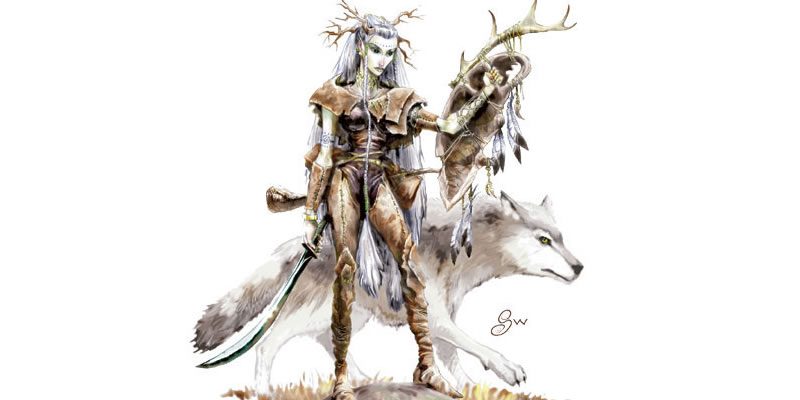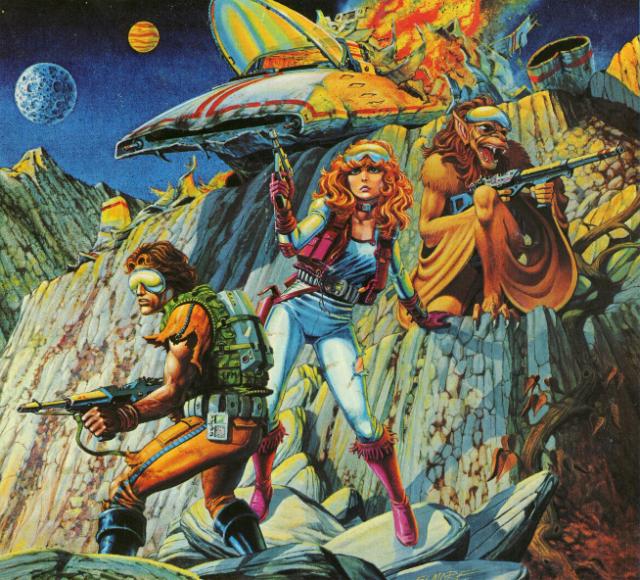The Druid Class, Part Three

Last time, I picked apart the 1e Druid class and its Unearthed Arcana update. Now I’m moving on to Advanced Dungeons & Dragons, Second Edition – the earliest edition I’ve personally run or played. Superficially, the 2e Druid is so similar to the 1e Druid that it’s tempting to gloss over a comparison entirely. I’d miss a chance to talk about this class in eye-bleeding detail, though, and who wants that? Perish the thought. Also, there’s the Complete Druid’s Handbook and Skills & Powers iterations.
2e
The first change to the Druid is that there’s none of this 14-Hit-Die nonsense. Druids build their way up to nine HD just like Clerics, and from there advance at 2 hit points per level just like Clerics. This is a through line of 2e’s changes – Druids are very much more like a variant Cleric than they are off doing their own thing. That raises questions, though, about why the Druid has much steeper ability score prereqs than the Cleric does – Wis 12/Cha 15 versus Wis 9. I don’t want to skip ahead too many months of this column, but the article on the 2e Cleric is going to be a doozy.
But I digress. Instead of having a completely freestanding spell list, the 2e Druid has a spell list cobbled together out of major and minor access to different Spheres than the Cleric: major access to All, Animal, Elemental, Healing, Plant, and Weather, and minor access to Divination. I had forgotten that the ban on Druids using any written magic items persisted through 2e. Druids also cannot turn undead, which I’m pretty sure was a common absence in other 2e specialty priest classes. (Dear Lord, so many specialty priest classes in mid-to-late 2e…)
The rest of the Druid’s class abilities before Hierophant status are so similar as to be essentially identical, though they might have tweaked the level at which a few things are granted. I have to note that the last few years of paleontological research, in which we have learned just how closely dinosaurs are related to birds, suggests to me that “velociraptor” might be a valid answer for the Druid’s ability to shapeshift into a bird form, and failing that argument, surely reptile qualifies? (Shapeshifting into dinosaurs is a big part of high-level druid shapeshifting in 5e, so I’ll be circling back to this point.)
Ah, the Ethos. The writeup in the Druid class section is almost identical in character to its 1e precursor, though there’s a revision of the rules on mistletoe – same implements as before, but now you can gather it on the night of any full moon, not just Midsummer’s Eve. This is still a weird rule, considering how screwed you are if you don’t have it and how often I assume DMs just handwaved that, but now there’s some great potential for the Druid (along with the rest of the PCs, one hopes) to have to enter the darkest parts of the forest and find adventure once a month, rather than once a year. (“Just kidding, is werewolf.”)
The point I want to make about the Ethos, though, is that there’s additional text relevant to it in the discussion of what True Neutral alignment means.
“True neutral characters sometimes find themselves forced into rather peculiar alliances. To a great extent, they are compelled to side with the underdog in any given situation, sometimes even changing sides as the previous loser becomes the winner. A true neutral druid might join the local barony to put down a tribe of evil gnolls, only to drop out or switch sides when the gnolls were brought to the brink of destruction. He would seek to prevent either side from becoming too powerful. Clearly there are very few true neutral characters in the world.”
What I take from this is that, for 2e, Good and Evil are just team jerseys, and Druids are the ultimate free agents. This sounds well-nigh unplayable, and like a great source for arguments at the table; fortunately I would bet that, of all the druids ever played in 2e, only a tiny fraction ever tried to play according to this writeup. (What I wouldn’t give for a survey of which classes got played the most in each edition, just to satisfy my curiosity and support or debunk my assumptions.)
The Druid hierarchy and advancement through combat remains part of the class, though advancement from Great Druid to Grand Druid is selected by the outgoing Grand Druid rather than won in combat, and life as a Grand Druid is explicitly presented as being very boring, even though you have a nice bump in spellcasting power. Once you’re a Hierophant Druid, you stop your spellcasting progression, and gain most of the hierophant powers from 1e. The ability to travel the planes is now limited to the elemental planes of Earth, Fire, Water, and Air, and confers no ability to conjure elementals – though that hardly matters, because the Elemental Sphere grants Conjure Fire Elemental and Conjure Earth Elemental as high-end spells.
Extra commentary from me aside, this class really is very similar to its progenitor, including all of the oddities of its XP chart, though the change to its HD progression make it much less abusive (not to say entirely non-abusive). On to the variant Druids of 2e…
Complete Druid’s Handbook
This has got to be one of the most uneven of the 2e Complete series – there are high points, such as the additional expository text on the Druidic language and Druidic Order, but what the Druid class didn’t need was a pile of extra restrictions on races (it’s not easy to restrict the Druid race options more, but they work it out) or how to spend their precious few starting non-weapon proficiency slots. It’s like this: this book has not just Kits, but also “Branches,” which are like Kits for individual terrain types. According to the book, each Druid has to belong to a Branch, one of which is the “forest Druid” (the default Player’s Handbook writeup). There are a few additional races available for this Branch – all of them from the Complete Book of Humanoids, with relatively tight level progression limits.
The other Branches offer a different mix of abilities, requirements, and restrictions. For example, Jungle Druids may not wear any armor, while a few Branches add khopeshes and scythes to the weapons allowed. All in all, the Branches are okay, but I can’t help but feel that either a lighter touch or a greater willingness to make changes would have been better ways to go. Most of them replace the mistletoe requirements of the forest Druid with something much, much easier to acquire, so that much is mighty nice.
Now, what 2e definitely needed was an additional subsystem with detailed rules for running a small farm. This book is here to help! Much like in Pendragon, the weather can “crit” on you, in a sense – a roll of a 1 on the Farm Random Events table can really ruin your day, no matter how good you are at Agriculture. I don’t have a problem with that, as such, but I do find it interesting that the bad outcomes on that table are more numerous and more severe than the better-than-neutral outcomes. The deck is certainly stacked against you in this system, which is probably how medieval farmers felt about it.
Next up we have Kits for druids. There’s a lot of overlap with the Ranger kits, thematically, but none of these reach the gonzo heights of some of the Ranger’s options. All but a few boil down to “a particular societal niche or life situation,” such as the Adviser, the Wanderer, or the Village Druid. It seems strange that you’d lock a character into one of these roles; they’re situations any normal druid could find herself in for the duration of a storyline, and then move on. Three of them, the Hivemaster, Shapeshifter, and Totemic Druid (and maybe the Beastfriend too?), make more substantive changes that feel like a different path of training.
The next chapter gets back to what the book does best: text exploring the oddities of the Druid class and how those details play out in the setting. In this case, it’s about Druid Circles and the hierarchy. I think if I were running a game with a druidic hierarchy like this, there would be substantially fewer than the requisite number of each hierarchical step – the nine Druids (12th level), three Archdruids (13th level), one Great Druid per Circle (14th level), and one Grand Druid per world (15th level). Well, okay, the Great and Grand steps might be filled at the start of play, because they are few in number, but I would almost certainly have fewer than nine 12th-level druids in a given region, because that seems like a lot of powerful NPCs to me. That power vacuum, with its dual political and mystical elements, would create pressure on the lower-level PC druid(s) to step up and take on assignments they are manifestly not prepared to handle. Anyway, this chapter does a phenomenal job of glossing over the artificiality of the restrictions on the Druid class and emphasizing their story potential, nowhere more so than in discussing hierophant druids. If you sanded off the level-based prerequisites, I could be convinced to make this chapter canon for a wide range of D&D settings, especially because the Druidic Order takes on some of the scheming, manipulative nature of archmages.
The chapter on roleplaying druids is a microcosm of the hit-or-miss nature of the whole book. Since I didn’t set out to write an article simply reviewing the Complete Druid’s Handbook, I’ll observe that this book has no better idea of what to do with True Neutral alignment than any previous text has. I am endlessly glad that restrictions on druidic alignment have gone the way of THAC0 in later editions.
Anyway, the rest of the book is spells, magic items (the best of which is definitely the mistletoe dart – its rules certainly suggest why it would be the favored murder weapon of the Norse gods), and a series of special systems for herbalism, magical groves, standing stones, and a certainly-unnecessary reprint of the 1e Druid class. On the whole, this book doesn’t particularly change the presentation of the Druid class, but it does give it some needed explanation of how it fits into the world and what goes on with the class’s unusual high-level structure.
Skills & Powers
None of the classes get a lot of compelling new material out of Skills & Powers, and the Druid is no exception. It surprised me a little that this system’s point-buy classes build the Druid on a substantially smaller point base than the Cleric, given how many non-spellcasting abilities the Druid picks up. Looking a little closer, though, it becomes clear that the Druid doesn’t pay for any of the hierophant abilities, presumably because they arrive so late in the game that many players would casually sell them off in exchange for some immediate gratification. (Of course, this is the problem with point-buy class abilities in the first place.)
The new options for Druids are quite stingy – the “better” Shapechange option for 15 points rather than 10 grants the same abilities in a piecemeal fashion, starting at 5th level rather than 7th. Certainly the most appealing things on offer are Hide in Shadows and Move Silently in natural environs, as the Ranger abilities. I don’t think you have to be too much of a powergamer to pick those up in preference to, say, speaking Druidic and a +2 bonus to saving throws against fire and electricity. An enemy won’t try to fireball what he doesn’t know is there, right?
Taken all together, the 2e Druid is very close to a reprint of its 1e source material, certainly much closer than the Bard was. Both in the Player’s Handbook and later splatbooks, 2e’s writers gave the old college try to explaining its idiosyncrasies, with what I judge to be mixed success. They really get jammed up when they forge ahead with True Neutral as an active choice rather than a simple avoidance of taking sides in the grand conflicts of Good vs. Evil; fortunately 3.0 and later editions have a clear-eyed view of how illogical and off-theme some of this gets, and they open the Druid class to an increasingly broad range of alignment options.
On the other hand, they did a damn fine job of finding the core conflicts that the class cares about and spinning that conflict in several different ways. It’s a more elevated and useful conversation about the class within the “average” setting than one sees in any other class’s Complete Handbook, thanks in large part to being the only class unified into a single, global hierarchy.
Next week we’ll move on to the 3.x Druid class, when the oddity and awkwardness of earlier editions fades away and is replaced with huge amounts of raw power.
Image Credit: Wizards of the Coast



